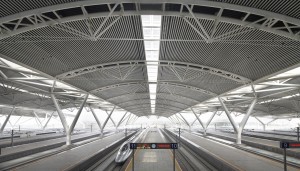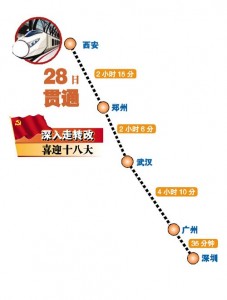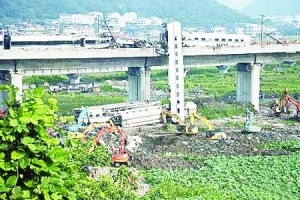I’ve always been a fan of railways. My grandfather worked for years at CP Rail in Calgary, Canada and through osmosis (he died when I was 11), I must have picked up the same love of rolling stock. I haven’t been too involved in the industry, minus a two-year stint with MTR Corporation in Hong Kong, but enjoy taking trains much more than planes, which I’m convinced are unsafe due to their reliance on computer technology (I mean, who has a computer that hasn’t crashed?).
Anyone who needs to get around China, dislikes air travel, or loves trains, must be quite excited about China’s burgeoning high-speed rail network. (Although, perhaps, nobody can be more excited than David Feng). Yes, it’s been beset by controversy and scandal, but the goals of the network remain noble: to conveniently connect all regions of the country quickly and efficiently. On 30 June, the latest (and perhaps most anticipated) leg of the network began operations, connecting Beijing and Shanghai in only 5 hours. Reviews of the new line have been positive, save for some of the food served on board.
Last year, another high-profile link opened much closer to home: the line between Guangzhou and Wuhan, in Hubei Province. Speeds on the line were up to 350km/hr, connecting the two cities in only 3 hours including several stops in between. After railways boss Liu Zhijun was brought down and safety concerns were publicized, speeds were decreased to 300 km/hr and the time to travel between the two cities increased to just over 4 hours with stops in between, or 3 hours direct. Since it’s opening, I’ve been excited about giving it a try and sampling one of the longest high-speed rail networks in the world. So, on July 4th I wandered on down to Shenzhen Station and bought a ticket to Guangzhou East (the high-speed trains connecting Shenzhen with Guangzhou South Station won’t begin until August).
Once arriving in Guangzhou East, I hopped a taxi to Guangzhou South, which will be the glamorous hub of high-speed rail travel in south China. The taxi ride took about 30 minutes, but buses will also get you there, albeit in 70 minutes.
The newly-completed Guangzhou South Station
Guangzhou South Station is immaculate and huge. It reminds me more of Beijing Capital Airport Terminal 3 than a typical Chinese railway station. It has a glass facade and airy feeling that swallows up the crowds of people inside. But like much in China, the station is mostly form over function: upon arriving, I wandered over to a ticket window to buy a ticket using a credit card or bank card. I was politely informed that she could only accept cash at the ticket window, but that I could use the ticket issuing machines if I wanted to pay electronically. The ticket issuing machines were downstairs, which is no small distance in a building that size. Nonetheless, I walked back to the escalators and went downstairs and looked for the ticket issuing machines. I found them and began purchasing a ticket, when it requested my Chinese ID card. The ticket lady upstairs had neglected to tell me, a white foreigner, that I could only use the machines with a Chinese ID. Alas, I decided to pay cash instead, but needed an ATM. Oh, I was told, there are ATMs conveniently located at either side of this massive complex. So I hiked to one side and was relieved to find four sparkling ATMs. However, upon closer inspection, they were switched off. So I huffed it to the other side of the building to find four more ATMS, also turned off. I then asked for some help, and was told ATMs were located outside the railway station, down a path, and inside a crowded, rickety, hot bus depot with no air conditioning. Lo and behold, there they were: two, gleaming ATMs that resembled an oasis of fresh water to a parched man in the desert. They spat out some kuai, and I was on my way.
Sweating (like a bing gui’r that’s melting, I was told), I hiked back to the train station and bought my ticket for the 4:15pm departure. I was set. Below are the impressions of my debut voyage on the high-speed rail between Guangzhou and Wuhan.
4:05pm - Put my ticket through the entry gate and proceeded downstairs to board the train. The station is immaculate and massive. I bought a first class ticket for RMB 740, regular class seats are RMB 465.
Heading downstairs to board the HSR
4:15pm - Train scheduled to depart, but doesn’t. I’m sitting in an empty train car, basically. There are 6 or 7 people with room for about 60.
4:24pm - We depart Guangzhou South Station.
The first class train cabin is almost empty
4:31pm – We finally start hitting our stride, as the train picks up speed. The first class seats are fantastic. They are similar to the old-style business class seats on airplanes. They don’t recline totally, but there is tons of legroom and they’re very comfortable. I’m tethering my phone’s internet to the computer, allowing me to type away as the world flies by outside.
4:42pm – The waitresses (er… train attendants?) come around to offer up some nourishment. I requested an orange juice and asked the price. “Mianfei,” (free) she replied. “啤酒也免费吗?” I asked with excitement. (Are beers also free?) Unfortunately, no.
4:43pm – I begin looking through the free box of food I received. Inside was a packet of roasted green peas, some kind of powdery coated peanuts, and a couple of small biscuits. None of it paired terribly well with orange juice.
5:02pm – I hadn’t eaten since the morning and the peanuts were not sufficient. So I wandered to the dining car, which was two cars away. I looked at the menu, which was conveniently (for laowai) written in English. Nothing on the menu really stood out though, except some breakfast items. The guy behind the counter assured me that breakfast was still being served, so I opted for wonton noodles and a beer.
I couldn't decide between A, B, or C so went with breakfast
5:11pm – We pulled into Shaoguan Station in north Guangzhou. This area of the province is beautiful, nestled in the mountains. The blue sky and late afternoon sun gave it a hazy, warm feeling.
5:13pm – We departed Shaoguan Station.
5:16pm – As I was nursing my beer, I was cringing as a guy behind me was screaming into his mobile phone. All I know is that he wasn’t speaking Putonghua or Cantonese, and he was really really angry at something.
The dining car, obviously after the angry screaming man left
6:02pm – 7:04pm – Stops in Leiyang West Station, Hanyang East Station, Zhuzhou West Station and Changsha South. Each stop is only for 2 minutes, maximum. The stations along some of these towns, like Guangzhou South, are immaculate and huge, but only a handful of people boarded the train. It seems it will take a long, long time before these stations reach anywhere close to capacity when it comes to passenger volumes.
7:36pm – The sun has almost set entirely as the train races through the dark. The whole journey has been comfortable, especially as my train cabin remained relatively empty. Enjoying the journey, I order another beer.
I can’t recall exactly what time the train arrived, but I’m sure it must have been a few minutes within the scheduled arrival time. The whole journey takes about 4 hours and 20 minutes with stops in between, or 3.5 hours with no stops at all, which is how I returned to Guangzhou.
Overall, the train journey provides an excellent alternative to traveling by air. In my humble opinion, it’s a superior option: it’s more environmentally-sustainable, you can get up and walk around mid-journey, you can visit a dining car if hungry/thirsty, and you can even use the Internet. Plus, you also avoid the ‘security theatre’ in place at airports and don’t have to show up for your train 90 minutes before it departs. All things considered, in some cases, traveling by train can be faster and more efficient than hauling it out to the airport for a flight.
Later this year, the Wuhan - Beijing section will be complete, meaning people in the PRD can reach the dusty capital in only 9 hours. In 2015, one of the last sections will be completed, which will link the network with the shores of Kowloon. Once that’s done, it will be possible to reach nearly every corner of the country by train. In this humble scribe’s opinion, that day can’t come soon enough.

 0
0











